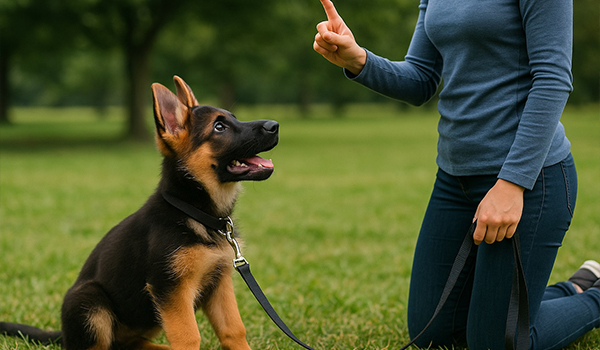Barking is a natural and essential form of communication for dogs. However, when it becomes excessive, it can be frustrating for you and your neighbors. The key to solving a barking problem isn’t to stop all barking—it’s to teach your dog when it’s appropriate to be quiet.
Success requires understanding why your dog is barking and then using targeted strategies to address the root cause.

Step 1: Identify the “Why” Behind the Bark
You can’t solve the problem until you know what’s triggering it. Common reasons for barking include:
- Alert/Warning: “Someone is at the door!” or “There’s a dog outside!”
- Boredom/Loneliness: “I have nothing to do!” or “I’m anxious when left alone.”
- Attention-Seeking: “Look at me! Pet me! Play with me!”
- Fear/Anxiety: “That loud noise scares me!” or “I’m nervous in this situation.”
- Play/Excitement: “I’m so happy you’re home! Let’s play!”
- Compulsive Barking: A repetitive, seemingly driven bark with no apparent trigger.
Step 2: Target the Training (Solutions for Each Cause)
Once you’ve identified the trigger, you can apply the right technique.
For Alert Barking: “Thank You” Method
The goal isn’t to punish the alert, but to control it.
- When your dog barks at a trigger (like the doorbell), calmly say, “Thank you,” or “Check it out.”
- Immediately ask for an incompatible behavior, like going to their “place” (a bed or mat) or sitting.
- Reward them with a high-value treat for being quiet and complying. This teaches them that alerting you is fine, but then being quiet is what earns the real reward.
For Boredom or Loneliness: Increase Enrichment
A tired dog is a quiet dog. This is especially crucial for apartment dogs.
- Physical Exercise: Ensure your dog gets adequate daily exercise through walks, runs, or play.
- Mental Stimulation: This is often even more important. Use puzzle toys, Kongs stuffed with food, snuffle mats, or short training sessions (5-10 minutes) to tire their brain.
- Manage the Environment: If your dog barks at people or dogs passing the window, close the blinds or use a static window film to block the view.
For Attention-Seeking: The “No Reward” Rule
Does your dog bark at you while you’re working or watching TV? They’ve learned that barking works.
- Completely ignore them. Do not look at them, talk to them, or touch them. Any attention, even saying “No!” is a reward.
- Turn your back or leave the room.
- The moment they stop barking, even for a second of silence, immediately turn around and give them the attention they want. This teaches that quiet gets attention, while barking gets nothing.
For Fear/Anxiety: Desensitization and Counter-Conditioning
This is a gradual process for dogs scared of specific things (like thunderstorms or vacuums).
- Desensitization: Expose your dog to a very low level of the fear trigger (e.g., a recording of thunder at a barely audible volume).
- Counter-Conditioning: While the trigger is present at this low level, give your dog something amazing, like their favorite chicken. The goal is to change their emotional response from “Scary!” to “Good things happen when I hear that!”
This process is often best done with the guidance of a professional trainer or veterinary behaviorist.
For General Training: Teach the “Quiet” Command
This is a fundamental tool for any owner.
- Let your dog bark 2-3 times. Say “Speak!” and reward them. (You need to get the behavior to happen to be able to put a cue on stopping it).
- After a few barks, hold a high-value treat in front of their nose. The smell will naturally cause them to stop barking to investigate.
- The moment they stop, say “Quiet” in a calm, clear voice and immediately give them the treat.
- Practice this repeatedly, gradually increasing the duration of silence required before they get the treat.
Step 3: What NOT to Do
Some common reactions can actually make the problem worse.
- Never yell. To your dog, yelling can sound like you’re joining in the barking. It also increases the overall arousal and stress level.
- Avoid punishment. Punishing a dog for barking, especially fear-based barking, can increase their anxiety and make the problem worse. It can also damage your bond.
- Don’t be inconsistent. If you sometimes reward barking with attention and other times ignore it, you are actually training them on a “variable schedule of reinforcement,” which is the most powerful way to create a persistent habit (like a slot machine). Consistency is key.
When to Seek Professional Help
If your efforts aren’t working, or if the barking is driven by severe anxiety (like separation anxiety), don’t hesitate to get help.
- Certified Professional Dog Trainer (CPDT) or Certified Applied Animal Behaviorist (CAAB): These professionals can assess your specific situation and create a tailored training plan.
- Your Veterinarian: Always rule out medical causes. Pain or an underlying health issue can sometimes manifest as excessive barking.
The Bottom Line
Stopping excessive barking requires patience, consistency, and a willingness to understand your dog’s needs. By addressing the root cause—whether it’s boredom, fear, or a simple bad habit—you can teach your dog to be quieter and build a stronger, more communicative relationship with your best friend.




